1.3: Introduction to the Piano Keyboard
- Page ID
- 51971
\( \newcommand{\vecs}[1]{\overset { \scriptstyle \rightharpoonup} {\mathbf{#1}} } \)
\( \newcommand{\vecd}[1]{\overset{-\!-\!\rightharpoonup}{\vphantom{a}\smash {#1}}} \)
\( \newcommand{\id}{\mathrm{id}}\) \( \newcommand{\Span}{\mathrm{span}}\)
( \newcommand{\kernel}{\mathrm{null}\,}\) \( \newcommand{\range}{\mathrm{range}\,}\)
\( \newcommand{\RealPart}{\mathrm{Re}}\) \( \newcommand{\ImaginaryPart}{\mathrm{Im}}\)
\( \newcommand{\Argument}{\mathrm{Arg}}\) \( \newcommand{\norm}[1]{\| #1 \|}\)
\( \newcommand{\inner}[2]{\langle #1, #2 \rangle}\)
\( \newcommand{\Span}{\mathrm{span}}\)
\( \newcommand{\id}{\mathrm{id}}\)
\( \newcommand{\Span}{\mathrm{span}}\)
\( \newcommand{\kernel}{\mathrm{null}\,}\)
\( \newcommand{\range}{\mathrm{range}\,}\)
\( \newcommand{\RealPart}{\mathrm{Re}}\)
\( \newcommand{\ImaginaryPart}{\mathrm{Im}}\)
\( \newcommand{\Argument}{\mathrm{Arg}}\)
\( \newcommand{\norm}[1]{\| #1 \|}\)
\( \newcommand{\inner}[2]{\langle #1, #2 \rangle}\)
\( \newcommand{\Span}{\mathrm{span}}\) \( \newcommand{\AA}{\unicode[.8,0]{x212B}}\)
\( \newcommand{\vectorA}[1]{\vec{#1}} % arrow\)
\( \newcommand{\vectorAt}[1]{\vec{\text{#1}}} % arrow\)
\( \newcommand{\vectorB}[1]{\overset { \scriptstyle \rightharpoonup} {\mathbf{#1}} } \)
\( \newcommand{\vectorC}[1]{\textbf{#1}} \)
\( \newcommand{\vectorD}[1]{\overrightarrow{#1}} \)
\( \newcommand{\vectorDt}[1]{\overrightarrow{\text{#1}}} \)
\( \newcommand{\vectE}[1]{\overset{-\!-\!\rightharpoonup}{\vphantom{a}\smash{\mathbf {#1}}}} \)
\( \newcommand{\vecs}[1]{\overset { \scriptstyle \rightharpoonup} {\mathbf{#1}} } \)
\( \newcommand{\vecd}[1]{\overset{-\!-\!\rightharpoonup}{\vphantom{a}\smash {#1}}} \)
Knowledge of the layout of the piano keyboard is essential to understanding music notation. Figure 1 provides a picture of part of the piano keyboard:

(The graphics of the keyboard in Figure 1 and below are modified from Tobias R. – Metoc, http://en.Wikipedia.org/wiki/File:Klaviatur-3-en.svg [Accessed 01 May 09])
Notice that in Figures 1 and 2 that the piano keyboard has groupings of two and three black keys—twins and triplets.
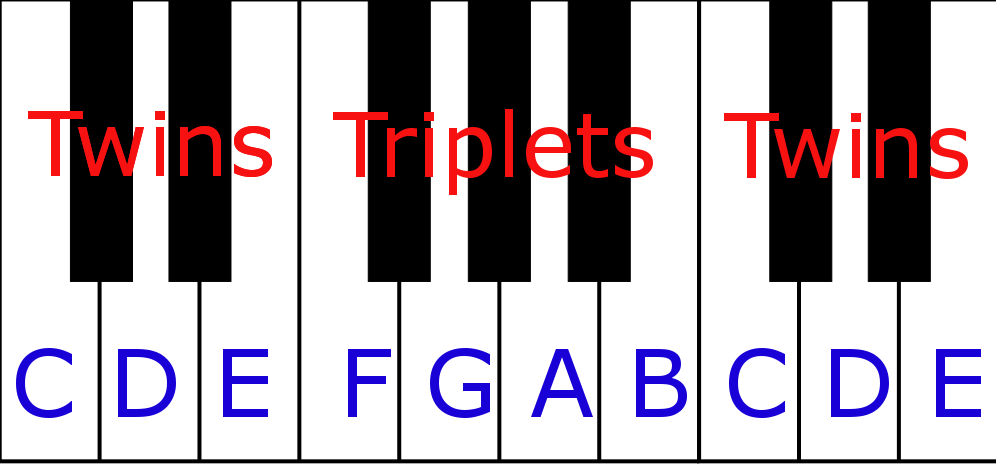
The note “C” is always found immediately to the left of the twins of black keys. The musical alphabet (A, B, C, D, E, F, G) repeats throughout the range of the piano keyboard (Figure 1).
The whole steps and half steps are arranged in music notation by referring to the keyboard. Consider these intervals in Figure 3 which are half steps:

The music notation in Figure 3 represents these keys on the piano in Figure 4:
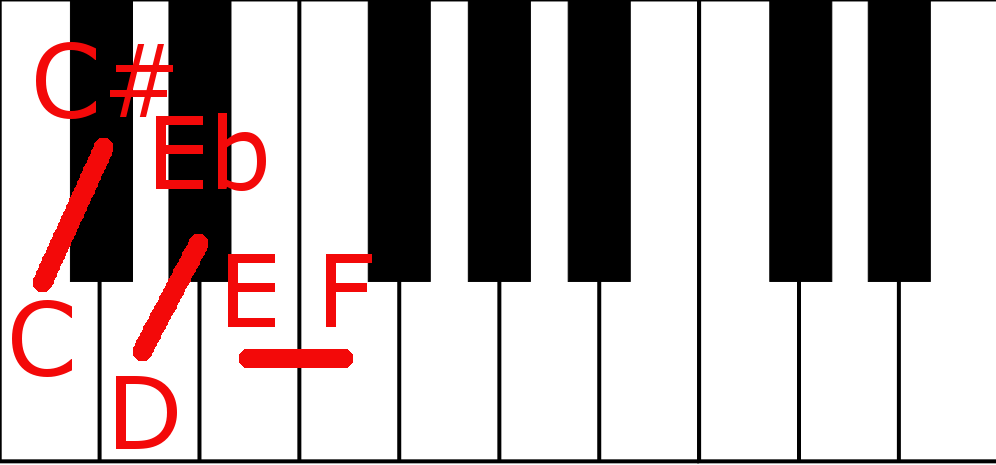
Notice that most half step movements are from white to black keys or black to white keys. There are two important exceptions, however, that every music student must memorize. E to F and C to B are half step. These are half step intervals from a white key to a white key.
In Figure 5 the pairs of eighth notes are all whole steps. Whole steps cover the same distance as two half steps moving in the same direction:

Most movements from a line to a space or a space to a line in the music notation result in whole steps. Again, however, the exceptions happen around E and F or B and C.
Movement from C to D on the piano keyboard is a whole step, there is a black key (C# or Db) between the C and D keys (Figure 6):
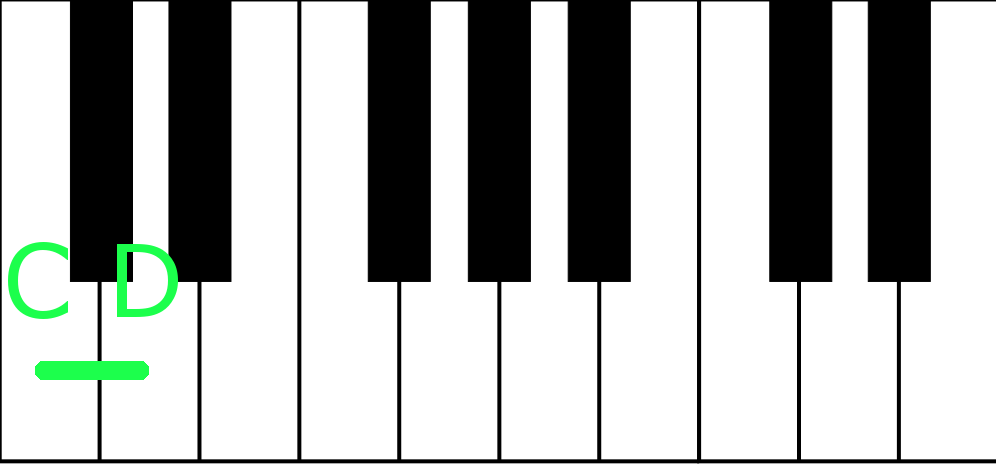
Movement from D to E on the piano keyboard is a whole step, there is a black key (D# or Eb) between the D and E keys (Figure 7):
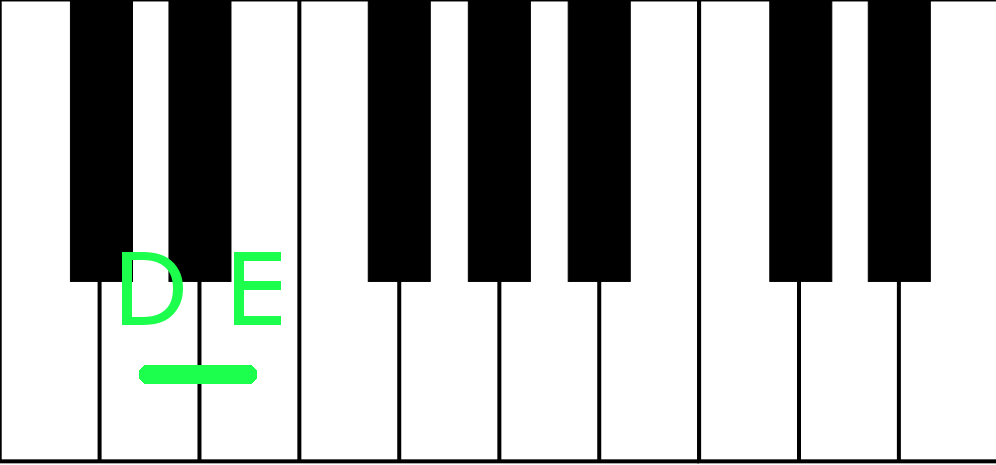
Movement from E to F, however, is not a whole step. These are adjacent keys. Instead a whole step is from E to F#.
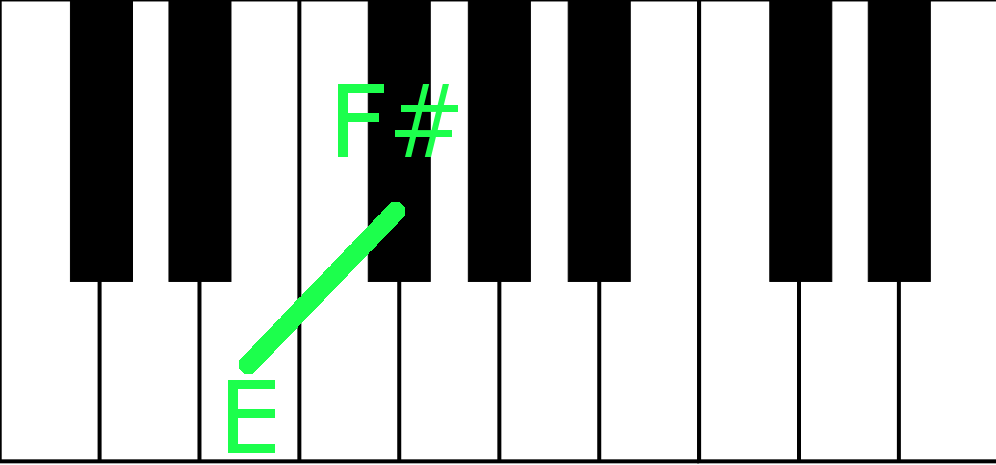
Not all keyboards instruments have the same arrangement of white and black notes. For further information on keyboard instruments and an introduction to the piano keyboard see:
Introduction to the piano keyboard (11 minutes) RealPlayer | Windows Media | iPod or QuickTime Player (mp4)


